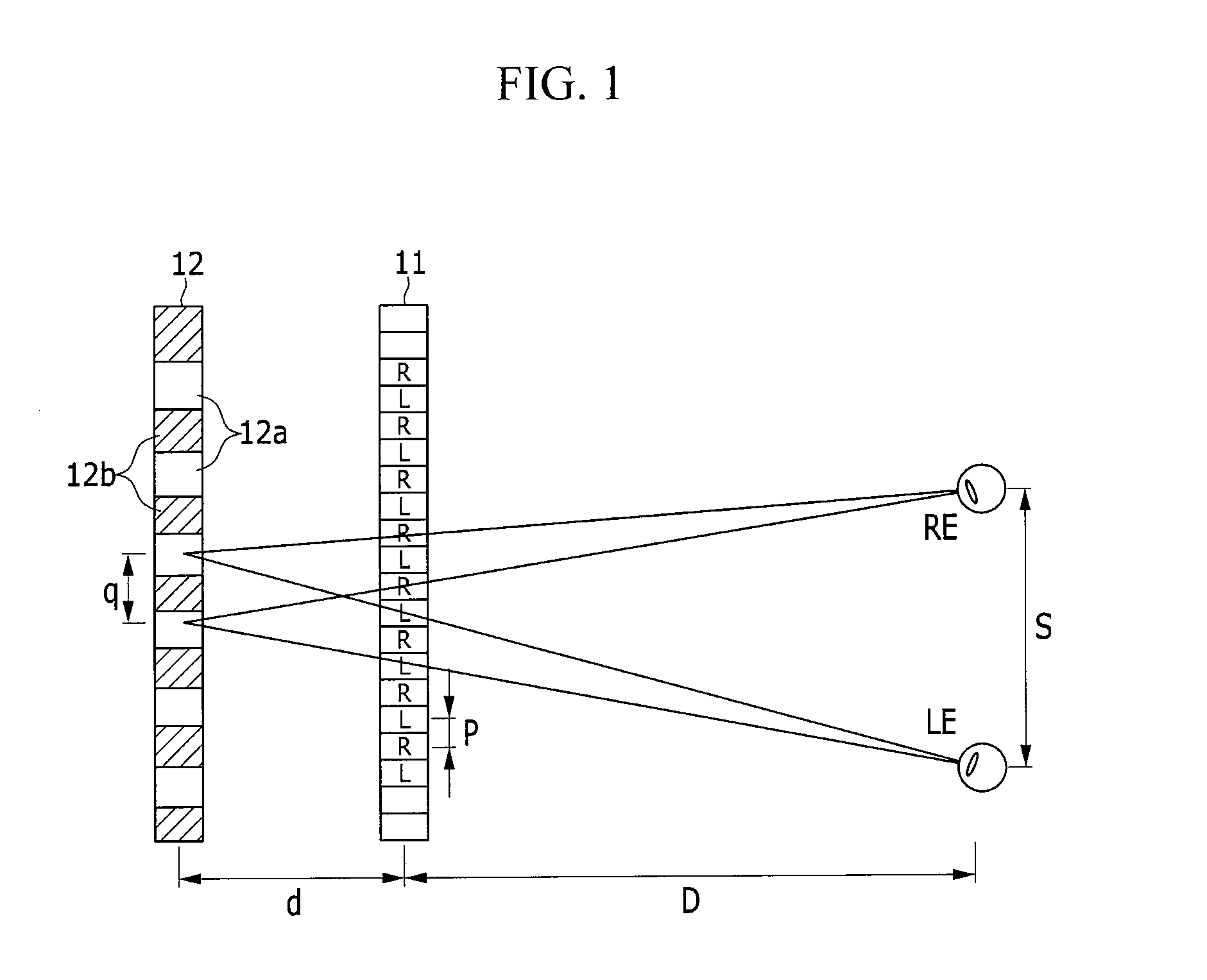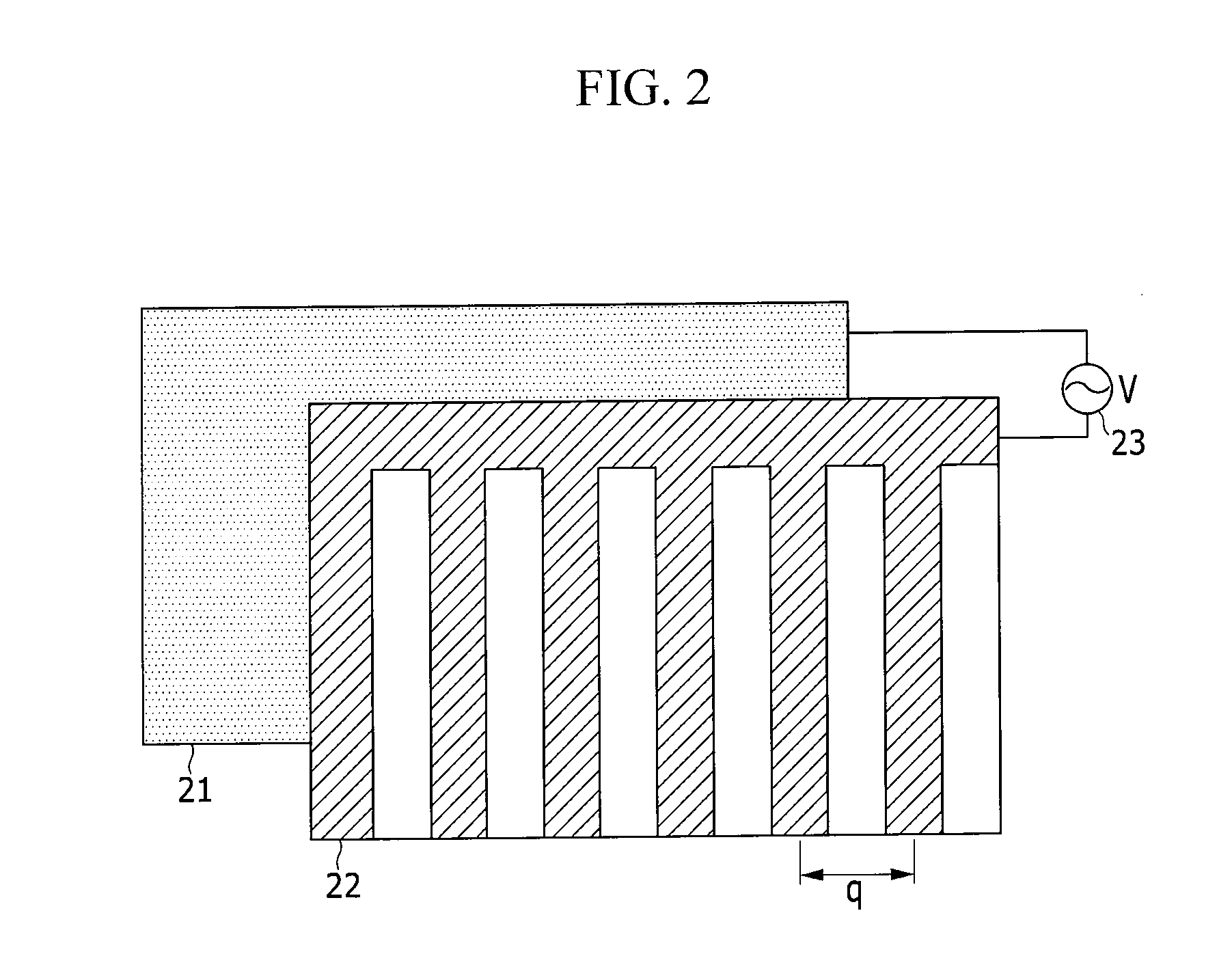System for controlling brightness flicker of parallax barrier LCD that has wide viewing angle and method thereof
a technology of parallax barrier and wide viewing angle, applied in the field of parallax barrier lcd, can solve the problems of brightness flicker, inability to implement stereoscopic image, and very limitative viewing angle of the viewer, and achieve the effect of minimizing brightness flicker and comforting feeling
- Summary
- Abstract
- Description
- Claims
- Application Information
AI Technical Summary
Benefits of technology
Problems solved by technology
Method used
Image
Examples
first embodiment
As a first embodiment, an operation to minimize the brightness flicker by controlling the voltage applied to the split barrier electrodes will be described below.
The display panel formed of the liquid crystal display device maintains a balance state even when a driving voltage is not applied to the electrode (cell), but when the driving voltage is applied to the electrode (cell), alignment of liquid crystals is changed depending on the voltage to display an image by using the resulting change of a polarization state. On the contrary, when the driving voltage applied to each electrode (cell) is eliminated, the display panel is restored to the original balance state.
FIGS. 10 and 11 are graphs showing one example in which brightness flicker generated depending on driving voltage in a stereoscopic display is detected, and FIG. 12 as an experimental example of the present invention is a graph showing an example in which brightness flicker depending on each driving voltage in a stereoscop...
second embodiment
As a second embodiment, an operation to minimize the brightness flicker by modulating a phase of the voltage applied to the split barrier electrodes will be described below.
The controller 102 splits the permittivity curve depending on turn-on of the split barrier electrodes 104 by time while turning on / off the split barrier electrodes 104 by controlling the voltage applied to the split barrier electrodes 104 through the driver 103 in order to display the stereoscopic image, and applies an appropriate waveform by modulating the phase of the voltage applied depending on each of split timings so as to minimize the brightness flicker.
FIG. 13 is a diagram showing improvement of brightness flicker by phase modulation in a system for controlling brightness flicker of a parallax barrier LCD having a wide viewing angle according to an exemplary embodiment of the present invention, and FIG. 14 is a diagram showing control of phase modulation in a system for controlling brightness flicker of a...
third embodiment
A third embodiment shows a method of minimizing brightness flicker caused due to moire depending on a viewing angle.
In general, the split barriers are not continuously changed but are changed in a stepwise fashion depending on the number of split barriers. However, when the viewing angle of the viewer is changed, the brightness is continuously changed as shown in FIG. 8.
Although the brightness flicker caused due to moire depends on design and characteristics of the display, brightness flicker of approximately 30% is substantially generated depending on the change of the viewing angle. Therefore, in the present invention, the brightness flicker is minimized by controlling independent driving of the split barrier electrodes as shown in FIG. 15.
As shown in FIG. 15, one or more intermediate steps are provided while moving the split barriers to the right side or the left side in order to correct decreased brightness by changing the viewing angle of the viewer, thereby minimizing the brig...
PUM
 Login to View More
Login to View More Abstract
Description
Claims
Application Information
 Login to View More
Login to View More - R&D
- Intellectual Property
- Life Sciences
- Materials
- Tech Scout
- Unparalleled Data Quality
- Higher Quality Content
- 60% Fewer Hallucinations
Browse by: Latest US Patents, China's latest patents, Technical Efficacy Thesaurus, Application Domain, Technology Topic, Popular Technical Reports.
© 2025 PatSnap. All rights reserved.Legal|Privacy policy|Modern Slavery Act Transparency Statement|Sitemap|About US| Contact US: help@patsnap.com



